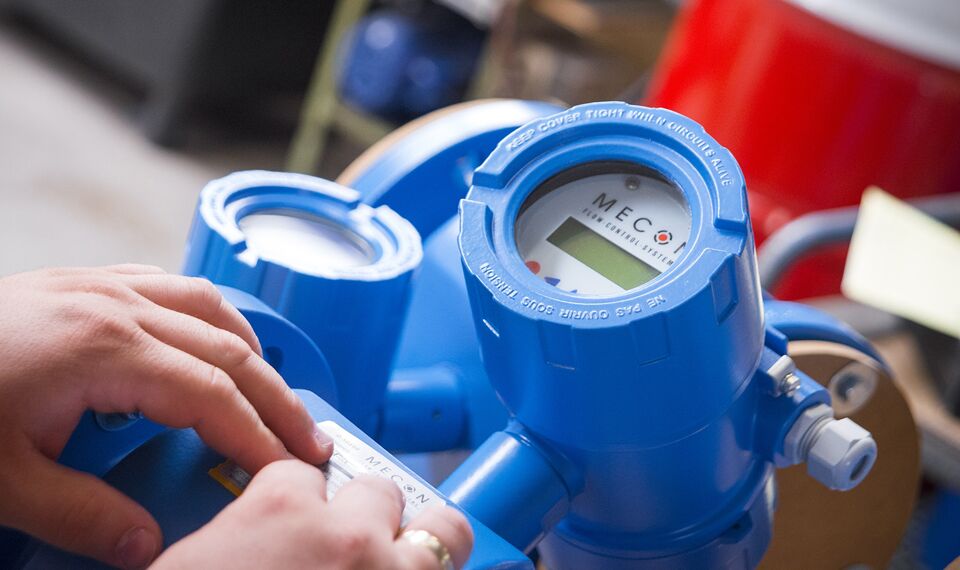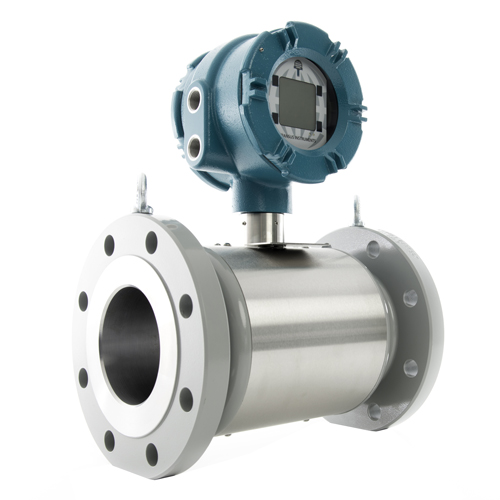Ultrasonic vs electromagnetic flowmeters
A comparison of 2 types of full bore flowmeters
Our flow measurement library:
When your process consists of aggressive or abrasive fluids you would definitely prefer a flowmeter that doesn’t obstruct the path of flow. Or if your flow architecture demands flow measurement, but there is no room for pressure drop, the full bore flowmeters come directly into mind. The solutions that are popular in those cases are ultrasonic and electromagnetic flowmeters (also known as magmeters or magnetic flowmeters). A comparison.
Electromagnetic flowmeters - operating principle
Magmeters generate a differential voltage across a coil. The measured voltage is proportional to the flow and can be converted to volume.
More explanation about the working principle of electromagnetic flowmeters:
Ultrasonic flowmeters - operating principle
Ultrasonic flowmeters measure the time it takes for a digital packet to reach the opposite side of the tube. The travelling time is proportional to the velocity of the fluid and can be converted to volume.
More explanation about the working principle of ultrasonic flowmeters:

Photo: electromagnetic flowmeter by Mecon.

Photo: a Transus ultrasonic flowmeter.
Different applications, different flowmeters
The electromagnetic flowmeter is used for measuring conductive liquids only, where low pressure drop and a high turndown are essential. A big advantage of magmeters is that measurement of sludge, slurries and chemicals are possible. And temperature, pressure, viscosity and density have no influence on the result.
Ultrasonic flowmeters on the other hand are also capable of measuring gases and non-conductive liquids, but have difficulties measuring substances that “scatter” sonic frequencies such as dirty fluids. Both flowmeters are capable of bidirectional measurements (forward and reverse flows).
Accuracy of electromagnetic and ultrasonic flowmeters
Accuracy performance of both magmeter and ultrasonic flowmeters are excellent. When measuring gases, temperature and pressure compensation is needed on ultrasonic flowmeters. Accuracy depends heavily on the way the meter is constructed. So its important to find a balance between the needed accuracy and costs. Ultrasonic flowmeters, for instance, can have up to 32 channels, which results in uncertainties of around +- 0,021%, but that comes at a price. Ultrasonic flowmeters can be compliant to MID regulations and are capable of custody transfer measurements.
Limitations of both flowmeters
The biggest limitation for electromagnetic flowmeters is the fact that the measured medium must be electrically conductive. And signal to noise ratio decreases dramatically when conductivity gets poor.
Ultrasonic flowmeters may have problems with measuring fluids with suspended solids, particles or bubbles which interrupt the path of the sound signal. As the sensors are installed in the pipe wall, they create sensor pockets which can accumulate dirt. Or in case of measuring gas, the sensor pockets may flood with condensate. These problems can often be overcome, but need attention when designing a system.
Electromagnetic flowmeters need an insulating lining in the pipe. When measuring aggressive or abrasive substances this needs attention. Nowadays extremely hard linings made of composite ceramics are available which makes them suitable for virtualy any liquid medium.
Installation aspects of full bore flowmeters
Flow disturbers like bends and valves cause inaccuracy in flowmeters. The magnetic flowmeter is much less sensitive for this phenomena. When there isn’t much space available magmeters might be the better choice, since they only need one diameter length upstream and two downstream. In most cases the inaccuracy caused by flowprofile is linear so the resulting error can be compensated for in the flowcomputer.
Ultrasonic meters typically need five diameters pipe upstream and 10 downstream.
An important consideration for magmeter installation is to ensure an electrically quiet atmosphere, with good grounding and shielded cables. For ultrasonic flowmeters a sonically quiet environment is necessary and placement of valves requires special attention.
Both types of flowmeters have problems with lightning strikes and power surges.
Both types of flowmeters are well suited for hazardous areas and can get ATEX certificated.
How about flowmeter OPEX (maintanance)?
Both flowmeters have no moving parts and are not prone to abrasive erosion. And magnet flowmeters are known for their incredible long operating life.
And ultrasonic APEX (investment) versus electromagnetic?
Both flowmeter technologies can bevery cost effective flow measurement. Cost comparison depends strongly on project parameters.
Downloads Electromagnetic flowmeters
Downloads Ultrasonic flowmeters
More information?
More information about our products or looking for a custom solution?
Please contact our Sales Engineers.
NL: +31 70 413 07 00
CN: +86-(0)10-60576210
USA: +(1) 973 383 0691
TW: +886-(0)3-5600560
Already know who you're dealing with? Contact your salesperson directly:
Look up salesperson
Any Questions?
More information about our products, services or looking for a custom solution?
Please contact our Sales Engineers.

WE MAKE YOUR TECHNOLOGY WORK
NL - Tel. +31 70 413 07 50
USA - Tel. +(1) 973 383 0691
CN - Tel. +86 (10) 56865822/56865835
TW - Tel. +886-(0)3-5600560